Abstract
Studies of the epidemiology of dyspepsia have been complicated by the use of different symptom definitions, subject populations and time frames of investigation. Published figures for the prevalence of dyspepsia vary from 20% to 40%, of which perhaps only a quarter can be attributed to peptic ulcer disease. General practitioners see only a fraction of the dyspepsia within the community, the majority of which is either ignored or treated by self-medication. However, dyspepsia still accounts for about 3-4% of all general practice consultations and for about 14% of all patients attending. In about half of all cases, even extensive investigation reveals no underlying organic lesion. There has been much recent interest in the clinical value of grouping dyspeptic symptoms into particular subtypes. These have been called ulcer-like, dysmotility-like and reflux-like. Although these patterns have descriptive value, there is no evidence that they result from discrete pathophysiological processes. Indeed, studies both in general practice and in the community show a large degree of overlap between them.
Full text
PDF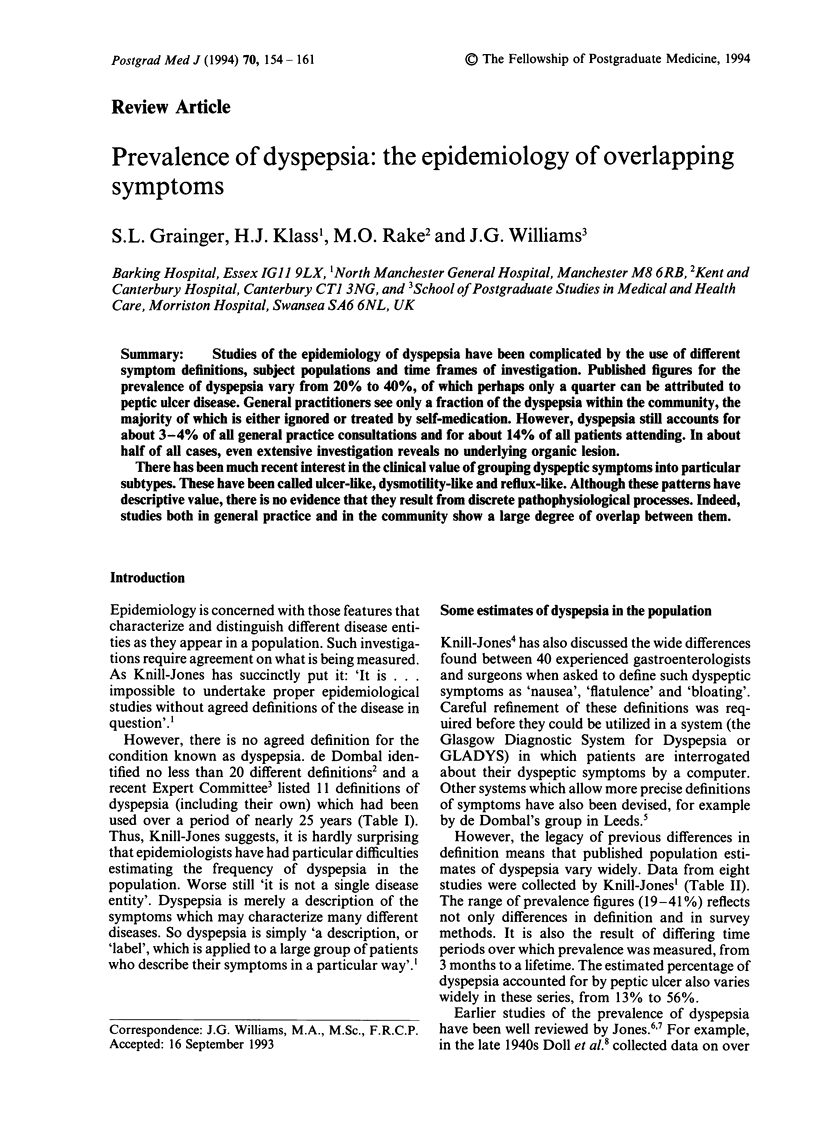

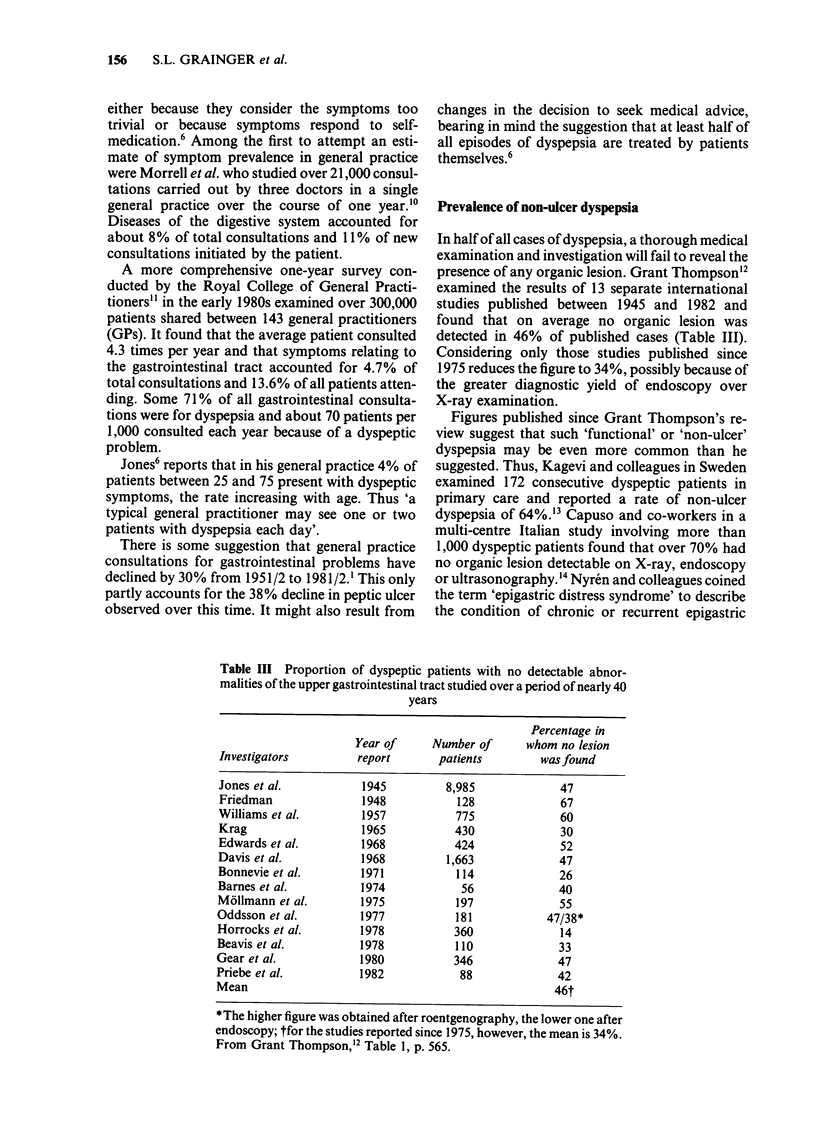
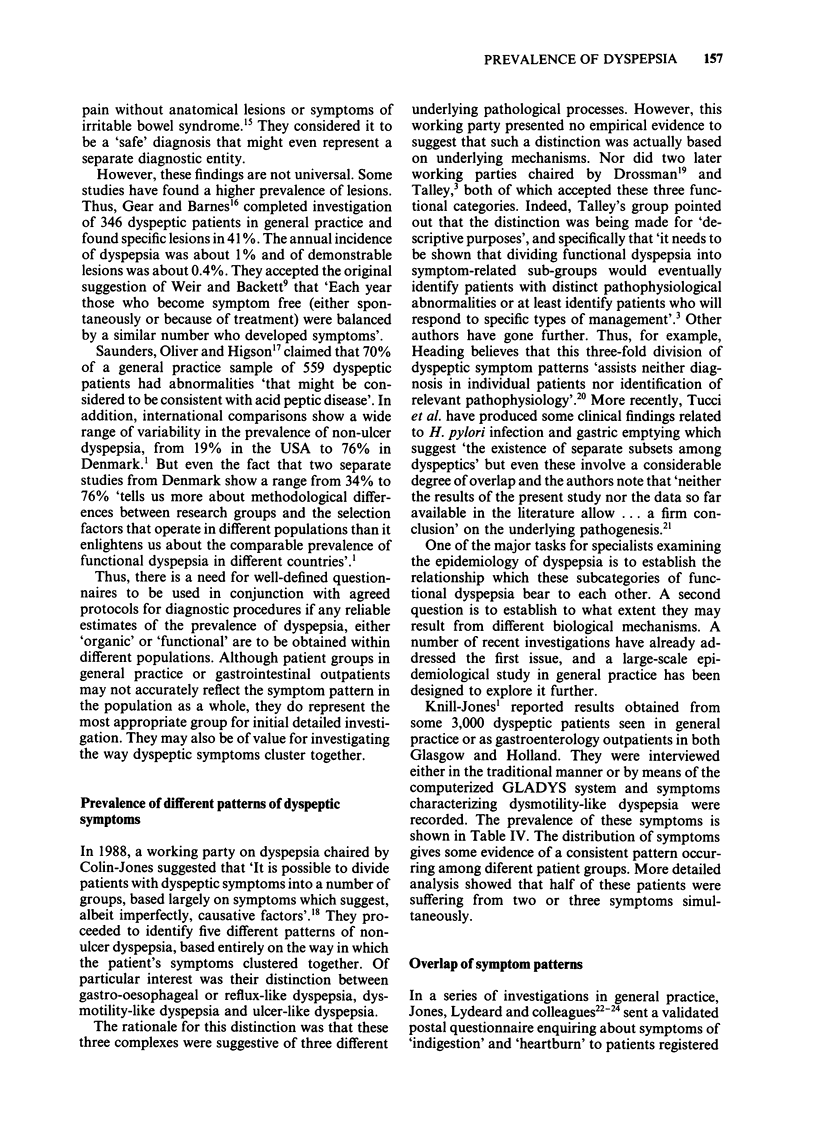
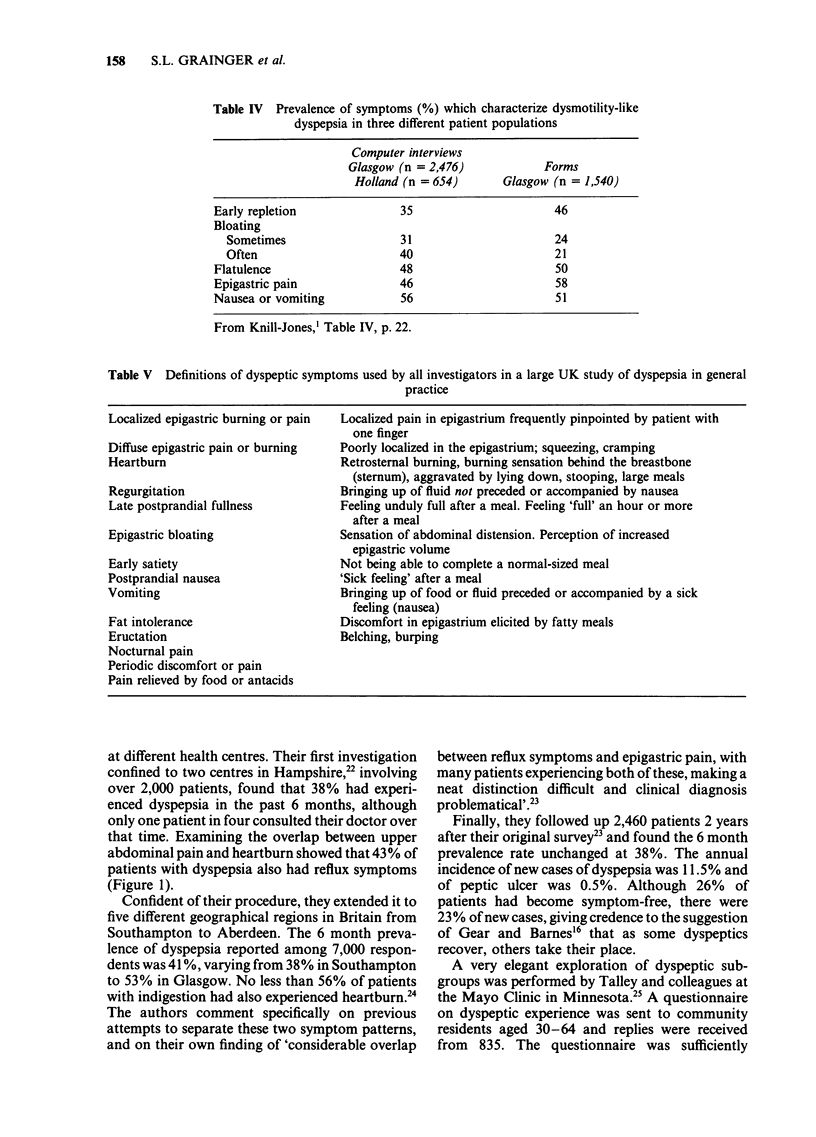
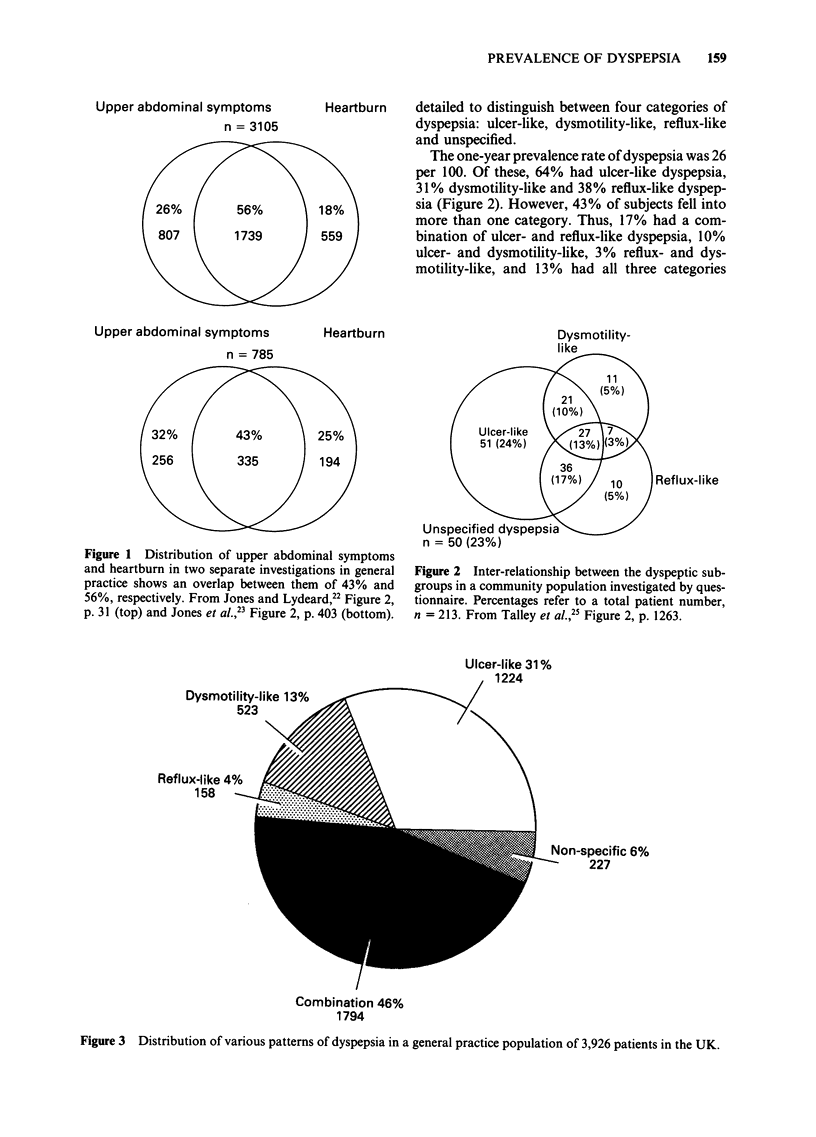

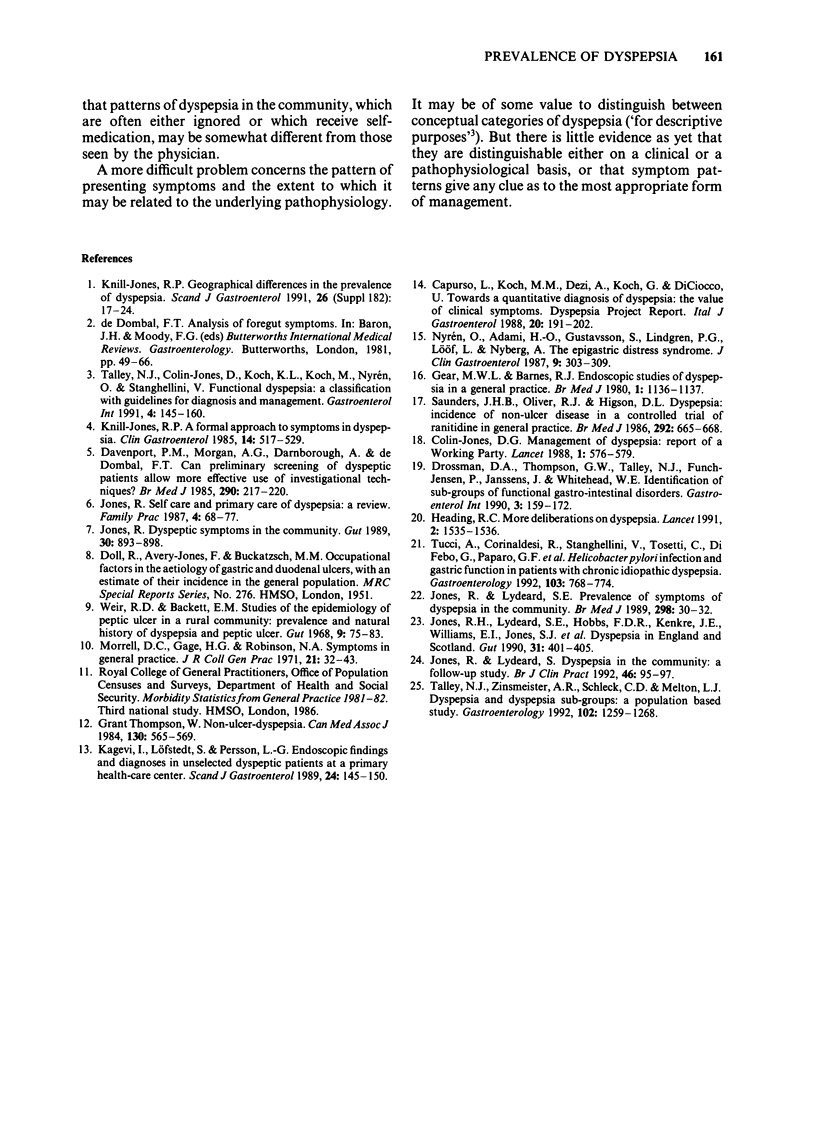
Selected References
These references are in PubMed. This may not be the complete list of references from this article.
- Davenport P. M., Morgan A. G., Darnborough A., De Dombal F. T. Can preliminary screening of dyspeptic patients allow more effective use of investigational techniques? Br Med J (Clin Res Ed) 1985 Jan 19;290(6463):217–220. doi: 10.1136/bmj.290.6463.217. [DOI] [PMC free article] [PubMed] [Google Scholar]
- Gear M. W., Barnes R. J. Endoscopic studies of dyspepsia in a general practice. Br Med J. 1980 May 3;280(6223):1136–1137. doi: 10.1136/bmj.280.6223.1136. [DOI] [PMC free article] [PubMed] [Google Scholar]
- Jones R. H., Lydeard S. E., Hobbs F. D., Kenkre J. E., Williams E. I., Jones S. J., Repper J. A., Caldow J. L., Dunwoodie W. M., Bottomley J. M. Dyspepsia in England and Scotland. Gut. 1990 Apr;31(4):401–405. doi: 10.1136/gut.31.4.401. [DOI] [PMC free article] [PubMed] [Google Scholar]
- Jones R. Dyspeptic symptoms in the community. Gut. 1989 Jul;30(7):893–898. doi: 10.1136/gut.30.7.893. [DOI] [PMC free article] [PubMed] [Google Scholar]
- Jones R., Lydeard S. Dyspepsia in the community: a follow-up study. Br J Clin Pract. 1992 Summer;46(2):95–97. [PubMed] [Google Scholar]
- Jones R., Lydeard S. Prevalence of symptoms of dyspepsia in the community. BMJ. 1989 Jan 7;298(6665):30–32. doi: 10.1136/bmj.298.6665.30. [DOI] [PMC free article] [PubMed] [Google Scholar]
- Jones R. Self-care and primary care of dyspepsia: a review. Fam Pract. 1987 Mar;4(1):68–77. doi: 10.1093/fampra/4.1.68. [DOI] [PubMed] [Google Scholar]
- Kagevi I., Löfstedt S., Persson L. G. Endoscopic findings and diagnoses in unselected dyspeptic patients at a primary health care center. Scand J Gastroenterol. 1989 Mar;24(2):145–150. doi: 10.3109/00365528909093029. [DOI] [PubMed] [Google Scholar]
- Knill-Jones R. P. A formal approach to symptoms in dyspepsia. Clin Gastroenterol. 1985 Jul;14(3):517–529. [PubMed] [Google Scholar]
- Knill-Jones R. P. Geographical differences in the prevalence of dyspepsia. Scand J Gastroenterol Suppl. 1991;182:17–24. doi: 10.3109/00365529109109532. [DOI] [PubMed] [Google Scholar]
- Morrell D. C., Gage H. G., Robinson N. A. Symptoms in general practice. J R Coll Gen Pract. 1971 Jan;21(102):32–43. [PMC free article] [PubMed] [Google Scholar]
- Nyrén O., Adami H. O., Gustavsson S., Lindgren P. G., Löf L., Nyberg A. The "epigastric distress syndrome". A possible disease entity identified by history and endoscopy in patients with nonulcer dyspepsia. J Clin Gastroenterol. 1987 Jun;9(3):303–309. [PubMed] [Google Scholar]
- Saunders J. H., Oliver R. J., Higson D. L. Dyspepsia: incidence of a non-ulcer disease in a controlled trial of ranitidine in general practice. Br Med J (Clin Res Ed) 1986 Mar 8;292(6521):665–668. doi: 10.1136/bmj.292.6521.665. [DOI] [PMC free article] [PubMed] [Google Scholar]
- Talley N. J., Zinsmeister A. R., Schleck C. D., Melton L. J., 3rd Dyspepsia and dyspepsia subgroups: a population-based study. Gastroenterology. 1992 Apr;102(4 Pt 1):1259–1268. [PubMed] [Google Scholar]
- Thompson W. G. Nonulcer dyspepsia. Can Med Assoc J. 1984 Mar 1;130(5):565–569. [PMC free article] [PubMed] [Google Scholar]
- Tucci A., Corinaldesi R., Stanghellini V., Tosetti C., Di Febo G., Paparo G. F., Varoli O., Paganelli G. M., Labate A. M., Masci C. Helicobacter pylori infection and gastric function in patients with chronic idiopathic dyspepsia. Gastroenterology. 1992 Sep;103(3):768–774. doi: 10.1016/0016-5085(92)90004-i. [DOI] [PubMed] [Google Scholar]
- Weir R. D., Backett E. M. Studies of the epidemiology of peptic ulcer in a rural community: prevalence and natural history of dyspepsia and peptic ulcer. Gut. 1968 Feb;9(1):75–83. doi: 10.1136/gut.9.1.75. [DOI] [PMC free article] [PubMed] [Google Scholar]


